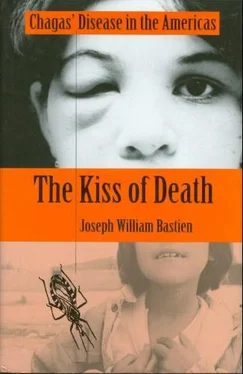8. Fetal infection can occur when the mother is in acute, indeterminate, and chronic phases of infection. Most infected pregnant women experience the chronic, or inapparent, form of the disease during their pregnancy, although cases of acute infection have been reported (Moya 1994). The fetus of an infected pregnant woman is usually unaffected, with no observed alterations in the growth or viability of the fetus, nor is the newborn predisposed to exhibit specific disorders. Chagas’ disease in the mother poses little risk to the baby during the perinatal period, which is after the twenty-eighth week of pregnancy through twenty-eight days following birth (Moya 1977, 1994; Moya and Barousse 1984; Castilho and Da Silva 1976).
If the fetus is infected, the outcome of pregnancy may be spontaneous abortion, fetal death, premature birth, low birth weight for gestational age, and even full-term delivery (Moya 1994). Congenitally infected infants present a broad spectrum of clinical manifestationsfrom grave illness with multisystem compromise (usually in premature neonates) to a total absence of symptoms at birth. Some infants remain asymptomatic; others present manifestations of the disease several weeks or months later. Clinical manifestations are encephalitis, meningoencephalitis, lesions in the retina or choroid, and elevated protein levels and cell counts in cerebrospinal fluid (Mufioz and Acevedo 1994).
9. Another route for T. cruzi is through the blood, by hematogenous spread, and through crossing of the placenta, with multiplication of the parasite in the Hofbauer cells (Bittencourt 1975). The amniotic fluid may provide another vehicle for T. cruzi to travel to fetuses as well as to obstetricians and gynecologists (Apt, Tejada, and Atrozz 1968; Bittencourt et al. 1981; Nattan-Larrier 1921). Contact of the skin with infected amniotic fluid could allow penetration of the skin, and T. cruzi has been found in the skin (Bittencourt 1976). Research is needed to evaluate the exact mechanisms of congenital transmission.
10. In laboratory experiments, animals have been infected by eating infected triatomines or mammals, but this has not been documented in experiments with humans (WHO 1991:34).
1. Volvulus is found among Andeans at high altitudes (13,500 feet) and its predisposing cause is a prolapsed mesentery intestine, which may be caused by T. cruzi within this organ.
2. This doctor’s behavior represents an elitist attitude that some Bolivian doctors exhibit in their treatment of peasants. There has been a considerable change within the 1990s with other Bolivian doctors who are able to communicate cross-culturally with the peasants (see Bastien 1992: 173-91).
3. See Marcondes de Rezende and Ostermayer 1994; Teixeira et al. 1980; Ribeiro dos Santos and L. Hudson 1980; Petry and Eisen 1989.
4. Dr. Mario Barragan Vargas conducted a five-year study of megacolon in Viacha, elevation 13,123 feet, located twenty miles from La Paz on the Altiplano. He found many cases of megacolon, which he attributed to altitudinal and genetic dispositions, not to Chagas’ disease.
5. See MacSweeney, Shankar, and Theodorous 1995; Cutait and Cutait 1991; and Da Silveira 1976 for a discussion of current procedures.
6. See Rezende and Rassi 1958; Godoy and Haddad 1961; Vieira and Godoy 1963; Morales Rojas et al. 1961; and Ifiiguez-Montenegro 1961.
7. In Brazil, chagasic esophageal problems are well known to the people, who refer to it in Portuguese as Mal de Engasgo (“Sickness of Choking”), Entalo (“Stuck”), and Embuchamento (“Engorgement”). The most frequent symptoms expressed are difficulty in swallowing, 99 percent; regurgitation, 57 percent; painful swallowing, 52 percent; belching, 41 percent; hiccups, 38 percent; sensation of plenitude, 32 percent; and coughing, 26 percent (Köberle 1968:90-91). Loss of weight, heartburn, and sour eructations are also very frequent, occurring in 70 percent of the cases. Advanced cases show elongation of esophagus muscles that can reach twenty-six times their normal weight. Advanced cases also have a predisposition to carcinoma, which may occur in 10 percent of the cases (Camara-Lopes 1962).
8. Nerve cells are decreased along the whole extension of the esophagus, resulting in loss of the coordinated peristalsis and sensitivity of the denervated musculature. This phenomenon, which occurs in the denervated hollow muscular organ, is called “aperistalsis” and describes the absence of esophageal motility (Brasil 1956). The denervated structure becomes supersensitive to any stimulus, inducing diffuse and severe spasms of the esophagus, which occasionally needs an urgent application of atropine.
9. The consistency of what is ingested is very important, because the transport of solids requires a more coordinated peristalsis than does the movement of liquids; also, excessive solid transport can cause a high overload to the damaged organ. In addition, increased consistency (reduced liquidity) of the contents of the esophagus favors the development of megaesophagus. Patients often drink large quantities of liquids to aid the passage of solids through the organ. Generally either very hot or very cold food intensifies difficulties in swallowing, and perhaps the associated abundant salivation constitutes a type of auxiliary mechanism for the deficient deglutition.
1. This center began in 1984 with assistance from Banco InterAmericano Desarrollo (BID) and a contract with the Universidad El Salvador de Buenos Aires, Ministerio de Previsión Social y Salud Pública, and La Universidad de Sucre.
2. Figures have been adjusted to the 1992 census.
3. Such pathologies include cardiac enlargement, mitral and tricuspid valve insufficiency, and pulmonary embolization. An abnormal left ventricular impulse may reflect the frequent apical aneurysm formation. Right-bundle-branch block is frequent. Complete heart block, high-grade ventricular ectopy, and atrial fibrillation have a grave prognostic significance, both aggravating the congestive heart failure and enhancing predisposition for sudden cardiac death (see Iosa 1994). (See Appendix 10.)
4. Ventricular arrhythmias are a prominent feature of chronic Chagas’ disease. Ventricular premature depolarization, often with multiple morphologies, is seen frequently. Bouts of ventricular tachycardia and arterial hypertension may occur as well as bradycardia and arterial hypotension (Braunwald 1988:1447; Iosa 1994).
5. See Brener (1994) and Appendix II for an overview of current theories on pathogenesis.
6. Investigators have found autoantibody and self-reactive T-cell formation in human and experimental T. cruzi infections (Teixeira, Teixeira, and Santos-Buch 1975; Cossio et al. 1974). Cross-reactive autoantibodies were mainly directed toward ubiquitous and evolutionary conservative molecules (Levin et al. 1989, Kerner et al. 1991, Van Voorhis et al. 1991) which lack clinical and biological significance for the different clinical forms of chronic Chagas’ disease.
7. The presence of an antibody against cardiac myosin is correlated with the development of chronic inflammatory cardiopathy in T. cruzi-infected mice (Tibbetts et al. 1994). Immunization with cardiac myosin HC induces aggressive myocarditis (Neu et al. 1987b). Cunha-Neto and colleagues (1995) have recognized a heart-specific T. cruzi cross-reactive epitope, with chronic heart lesions further indicating the involvement of cross-reactions of myosin and B13 in the pathogenesis of chronic Chagas’ disease.
Читать дальше












